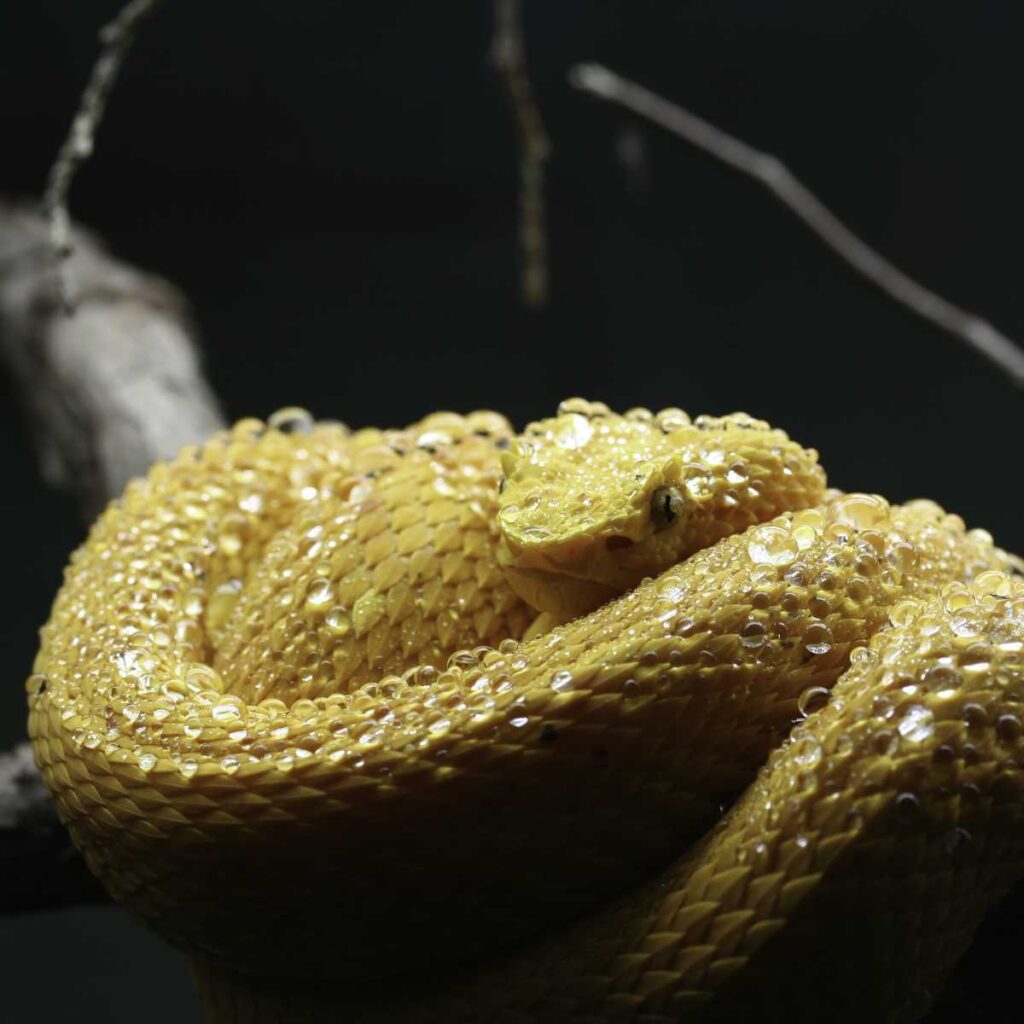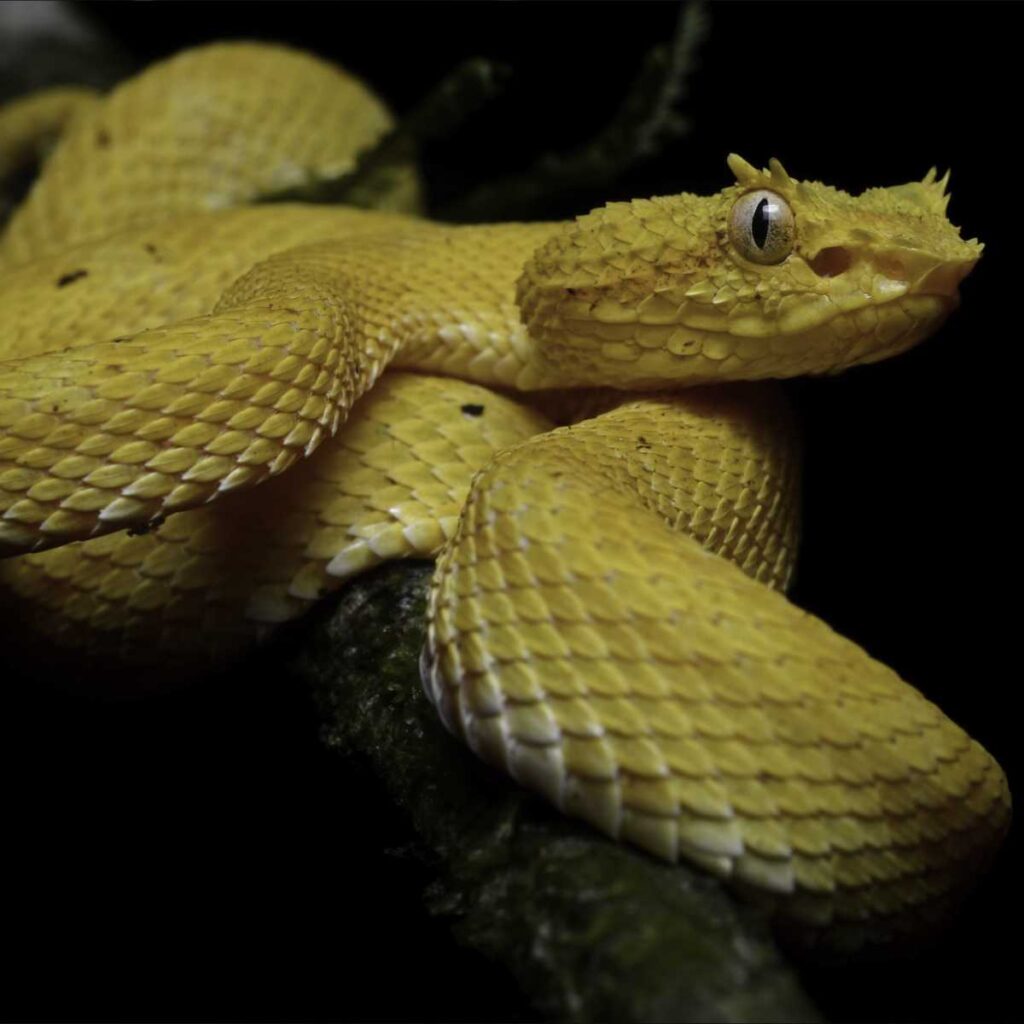Last Reviewed and Updated on March 11, 2023
One of the fanciest snakes out there, the eyelash pit viper, isn’t as innocent as it may look. The snake might capture your attention with its distinctive eyelash-like scales above their eyes, which gives it an elegant look, but it’s still a deadly snake. Read on and learn some of the most fascinating facts about eyelash viper snakes.
About Eyelash Vipers

Eyelash vipers (Bothriechis schlegelii), are a venomous species of pit viper that are found in Central and South America. There are many other common names for this snake; some of them are; Schlegel’s viper, eyelash pit viper, eyelash palm viper, horned palm viper…
In their native range, they can be found in a variety of habitats, including forests and rainforests. They are most commonly found in lowland areas but can also be found at higher elevations.
Eyelash vipers are relatively small, with adults typically measuring between 22 to 32 in / 55 to 82 cm in length. They have a wide triangular-shaped head and eyes with vertical pupils, as is common in venomous snakes. Their scales are keeled, meaning they have a ridge down the center, which gives them a rough texture.
These snakes are carnivorous, feeding on a variety of small animals like rodents, birds, frogs, and lizards.
The conservation status of eyelash vipers is considered to be as least concern with stable populations.
Interesting facts about eyelash viper snakes
You now know the basics, so let’s bite down into some interesting facts about eyelash viper snakes.

You might also like;
1. Their “eyelashes” are modified scales
The most distinguished feature of eyelash vipers is the set of modified scales above their eyes that resemble eyelashes. The purpose of these modified scales is thought to be camouflage, as they break up the shape of the snake, which makes it easier for the snake to hide.
2. Eyelash vipers give birth to live young
Female eyelash vipers give birth to live young rather than laying eggs. The number of young they give birth to can vary, with some litters containing as few as 2 offspring, while others can have up to 20. The young are born fully formed and are able to hunt for themselves shortly after birth.
3. Males can engage in mating rituals that last for hours (cobra)
Male eyelash vipers engage in courtship rituals called “dance of the adder,” which can sometimes last for hours. While doing this “dance,” the two males will assume an upright posture (cobra like) and will try to intimidate each other until one falls to the ground or is pushed away.
4. They come in many colors
What is surprising here is that the color variations can even be seen in one litter of snakes. They are typically bright green or yellow but can be dark grey, silver, white, brown, or pink.
5. Eyelash vipers are ambush predators
They are ambush predators, waiting for their prey to come close before striking with their venomous fangs.
Fun fact: eyelash vipers are known to select a specific ambush site and return to it year by year (in time for migration of birds etc.).
6. They are fairly frequent in the exotic pet trade, despite their venom
Their unique looks, vibrant colors, and small size make them fairy popular exotic pets, despite the fact they can deliver quick and painful bites that can be potentially fatal.
Luckily, the illegal trade, where these snakes would be captured from the wild and sold on the black market, isn’t common.
7. Eyelash vipers are front-fanged snakes
A front-fanged snake is a snake that has enlarged, grooved or hollow fangs located in the front of its upper jaw. These fangs are used to deliver venom to prey or as a defense mechanism against predators or perceived threats. Front-fanged snakes include some of the most venomous snake species, such as cobras, vipers, and coral snakes.
Rear-fanged snakes, like flying snakes, have fangs on the rear.
8. They have heat-sensitive organs on either side of the head
Eyelash vipers, like other pit vipers, have a pair of specialized organs called pit organs or heat-sensitive organs located on either side of their head, between the eye and nostril. These receptor organs are highly sensitive to thermal radiation and allow the snake to detect even the slightest differences in temperature in its surroundings.
9. Eyelashes prefer habitats near water
Eyelash vipers can be found in a variety of habitats, and although they are not strictly aquatic snakes, they are most commonly found near water sources, such as streams, rivers, and ponds, where their prey is also more abundant.
10. In some South American villages, people believe these snakes can wink (it’s just a myth, though)
In some small areas in South America, there is a myth among villagers that the eyelash viper will wink at its victim before striking. While a fin myth, it’s just that, as snakes don’t have eyelids, so they are incapable of winking.
